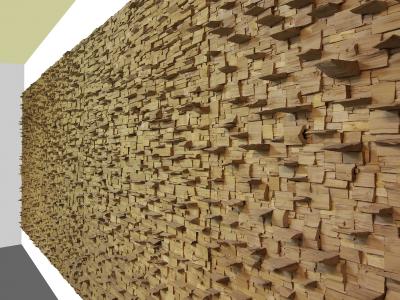Jan de Weryha-Wysoczański
Mediathek Sorted






































































































JJan de Weryha-Wysoczański was born in 1950 in Gdańsk/Danzig. His father came from a Galician aristocratic family and his mother had German ancestors. Both of his parents came from Lemberg.[21] After graduating from high school, in order to bridge a four-year waiting period for a place at university he took an apprenticeship in sculpture workshops in Gdansk. In 1971, after an intervention from the Ministry of Culture, he was awarded a place at the Sculpture Department of the State Academy of Fine Arts in Gdansk/Państwowa Wyższa Szkoła Sztuk Plastycznych w Gdańsku (PWSSP), today's Academy of Fine Arts/Akademia Sztuk Pięknych w Gdańsku. There he studied until 1976, first in Alfred Wiśniewski's sculpture class, and later in the class for sculpture in architecture under Adam Smolana, one of the most important professors in his field, with whom Magdalena Abakanowicz had also studied. In the early 1950s both professors were entrusted with restoring historical sculptures in Gdansk, and worked in the fields of monument sculpture, spatial and architectural sculpture, ceramics and the art of medal-making. After graduating, De Weryha worked as a freelancer, creating statuettes, reliefs and medals in bronze and ceramics. Until 1981 he was involved in the restoration of historic architectural sculptures on the houses that had been damaged during the Second World War.[22]
Successful in his professional life, de Weryha left Poland for Hamburg in 1981 for political reasons before the declaration of martial law, along with his wife Maryla, who had studied Polish philology, and his son Rafał. There he initially worked with drawings before turning to painting, small sculptural forms and medals in bronze, copper, wax and polyester. In 1996 he began to work figuratively and abstractly in wood, sometimes in large formats. Whilst he was working with large blocks of wood with a chainsaw and the tools of the trade, he said that he noticed the beauty and abstract quality of the raw material. Traces of these early experiments can still be found in the works made in 1997 (ill. 1-5). Active in Hamburg's cultural scene from the very beginning, he opened a studio in 1998 in a hall in the former Bundesbahn repair works in Hamburg-Harburg, an industrial building erected in 1883 and abandoned in 1990 and made available to him by the Hamburg cultural authorities.[23]
In 1999 this was followed by his design for a memorial in the Neuengamme concentration camp memorial site (ill. 18a-c), which commemorates more than six thousand Poles who had been deported to the camp after the Warsaw Uprising was suppressed in 1944. The memorial was inspired by the Hamburg branch of the Bund der Polen in Deutschland e.V., designed by the artist in an honorary capacity and financed by donations. Under the patronage of the Polish Consulate General and the Polish Catholic Mission it was inaugurated sixty years after the German invasion of Poland and the beginning of the Second World War by Hamburg's cultural senator Christiana Weiss in the presence of the Polish writer Andrzej Szczypiorski. In 2000 de Weryha exhibited his wooden objects for the first time. The exhibition was also opened by Christina Weiss as part of a series of events in Hamburg featuring culture from Poland. From 1998 to 2005, he created works placed on the ground and integrated into architecture (ill. 9-30, 38, 40, 41, 47-49) in his Harburg studio; and in 2001 he began making his "wooden panels" hanging on walls. (ill. 31-37, 39, 42-46).
In 2003 de Weryha wrote the following about the last group of works he had created: " In recent years my artistic deliberations have concentrated on researching wood as a material, and on understanding its structure and its core. This has led to the highest possible artistic state based on the celebration of the archaic nature inherent in wood. Here everything begins with the question of which technical means of material processing are available to the artist, and also to what extent. [...] I begin intuitively with the following question: To what extent can my intervention influence the material without depriving it of its identity? In practice, this works by introducing strict rules that the artist has to establish in his empirical engagement with nature. Certain rhythms then emerge, and also a certain monotony. I thematize these two phenomena in a continuous accentuation with a surprisingly vibrant equilibrium. At the same time I introduce a certain geometry, full of objective expressions that have impressed me in Minimal Art. On the other hand I am interested in the individual unrepeatable weave of artificially created, but natural looking wooden surfaces, which leave barely recognisable traces of interference by tools. This constant give and take between nature and the artist becomes a highly sublime and thoughtful process of mutual exchange. In turn this becomes the basis of my actions and opens up completely new solutions to me in surprising ways. [...] Some of the wooden panels, up to ten square metres in size, are huge and resemble reliefs, breathe archaically and have a monumental effect, testifying to strength and sublimity. These new wall works stand out principally on the grounds of their strongly developed architectural order and powerfully charged wooden structures, which are connected in specific rhythms. This singular constellation, which opens up unexpected forms of expression, allows me to define anew wood as a material".[24]
[21] detailed biography at Maryla Popowicz-Bereś 2014, p. 5 ff. (see note 16)
[22] illustrations on the website of the artist
[23] former Federal Railroad Repair Works in Hamburg-Harburg, Schlachthofstraße 1-3, http://www.hamburg.de/flaechenrecycling/142834/bundesbahn-ausbesserungswerk/; historical photographs of the studio on the website of the artist; Bianca Fischer: Jan de Weryha-Wysoczański: Alles Holz - Eine Hommage an Mutter Natur, in: Harburger Anzeigen und Nachrichten, 22. August 2002, text available online: http://www.kultura-extra.de/kunst/portrait/jan_de_weryha_a.html
[24] Jan de Weryha-Wysoczański: Ein paar Worte über meine neuesten Arbeiten „Hölzerne Tafeln“, 2003; available online at http://www.kultura-extra.de/kunst/portrait/jan_de_weryha_a.html





















































































